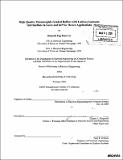| dc.contributor.advisor | Eugene A. Fitzgerald. | en_US |
| dc.contributor.author | Lee, Kenneth Eng Kian | en_US |
| dc.contributor.other | Massachusetts Institute of Technology. Dept. of Electrical Engineering and Computer Science. | en_US |
| dc.date.accessioned | 2009-10-01T15:41:38Z | |
| dc.date.available | 2009-10-01T15:41:38Z | |
| dc.date.copyright | 2009 | en_US |
| dc.date.issued | 2009 | en_US |
| dc.identifier.uri | http://hdl.handle.net/1721.1/47779 | |
| dc.description | Thesis (Ph. D.)--Massachusetts Institute of Technology, Dept. of Electrical Engineering and Computer Science, 2009. | en_US |
| dc.description | Includes bibliographical references (p. 152-155). | en_US |
| dc.description.abstract | We have investigated the use of a continuous, linear grading scheme for compositionally-graded metamorphic InxGal-As buffers on GaAs, which can be used as virtual substrates for optical emitters operating at wavelengths > 1.2 gm. Such virtual substrates will allow access to new materials that can be used for designing optical and electronic devices with superior characteristics and performances compared with conventional devices that are grown lattice-matched on standard substrates such as GaAs and InP. In addition, the principles behind such graded buffers can be used to bridge different lattice-constants, which can be a pathway to future integration of previously distinct classes of devices that have been defined by the lattice-constant on which they were built (e.g. Si-based, GaAs-based, InP-based etc.). Graded buffers with threading dislocation densities (TDD) < 9.5 x 104 cm-2, at a final composition of x = 0.346 were obtained, representing the lowest value ever achieved at or around this composition. Photoluminescence (PL) measurements were carried out on InGaAs quantum wells (QWs) that were re-grown on these buffers, and high luminescence efficiency was observed in the 1.2-1.5 tm wavelength range. Ridge waveguide QW-separate confinement heterostructure lasers and heterojunction bipolar transistors (HBTs) were also grown on the graded buffers to demonstrate their applicability for device applications. Pulsed threshold current densities of 262 Ac2 at room temperature were obtained for 2 mm long strained-InGaAs QW emitting at 1320 nm, with peak output powers up to 40 mW. Preliminary tests on the unoptimized HBTs revealed that they operate with dc current gains of up to 13. A new class of graded buffers using all-binary III-V semiconductors has also been demonstrated. Thin constituent layers of GaAs and InP are combined such that they act in a mechanically-similar fashion as a random alloy. | en_US |
| dc.description.abstract | (cont.) We term this combination of many thin layers of constituent materials a Digital Metamorphic Alloy (DMA). The DMAs are used to replace conventional random-alloys in a metamorphic buffer layer. Such a DMA buffer has superior thermal conductivities to, and avoids materials growth-related problems associated with, conventional compositionally-graded random-alloy metamorphic buffers. The method of fabricating DMAs is described. Lattice-constant grading from GaAs to InP has been carried out using both the DMA concept, and a hybrid random-alloy-buffer/DMA approach. | en_US |
| dc.description.statementofresponsibility | by Kenneth Eng Kian Lee. | en_US |
| dc.format.extent | 155 p. | en_US |
| dc.language.iso | eng | en_US |
| dc.publisher | Massachusetts Institute of Technology | en_US |
| dc.rights | M.I.T. theses are protected by
copyright. They may be viewed from this source for any purpose, but
reproduction or distribution in any format is prohibited without written
permission. See provided URL for inquiries about permission. | en_US |
| dc.rights.uri | http://dspace.mit.edu/handle/1721.1/7582 | en_US |
| dc.subject | Electrical Engineering and Computer Science. | en_US |
| dc.title | High quality metamorphic graded buffers with lattice-constants intermediate to GaAs an InP for device applications | en_US |
| dc.type | Thesis | en_US |
| dc.description.degree | Ph.D. | en_US |
| dc.contributor.department | Massachusetts Institute of Technology. Department of Electrical Engineering and Computer Science | |
| dc.identifier.oclc | 428978173 | en_US |
